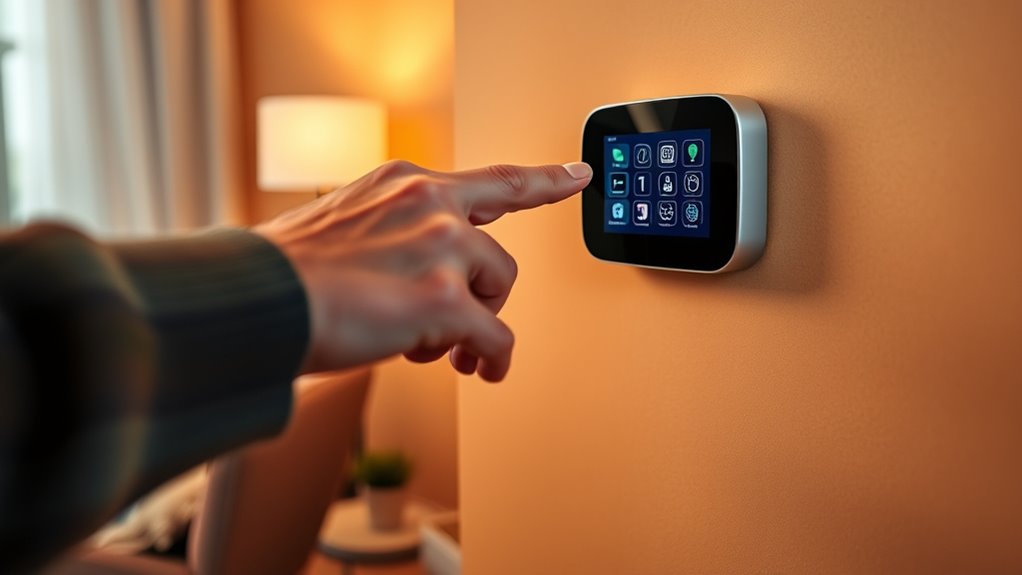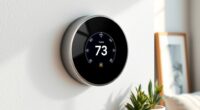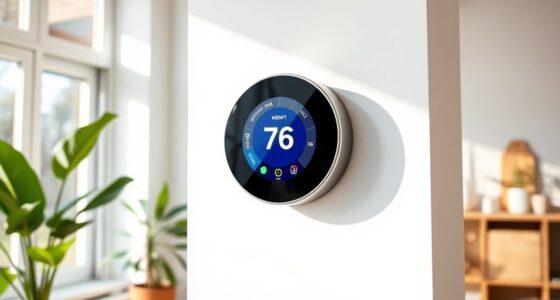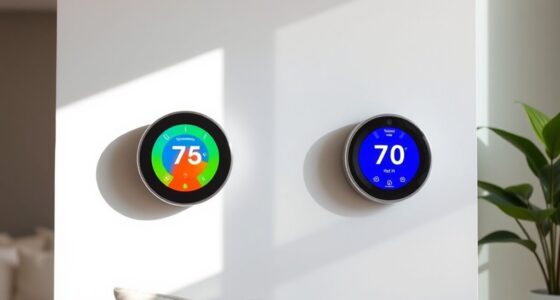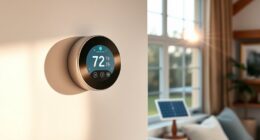When choosing a smart thermostat for elderly or accessibility needs, opt for devices with simple, intuitive controls like large buttons or clear displays, and voice command compatibility with Alexa, Google Assistant, or Siri. Look for features such as adaptive learning routines, remote access, and safety alerts to boost independence and safety. Ensuring user-friendly design and seamless system integration makes managing temperature easier. If you’d like to discover specific models and tips, there’s more to contemplate below.
Key Takeaways
- Prioritize models with intuitive interfaces, large displays, or tactile controls for easy use by elderly users.
- Ensure compatibility with voice assistants like Alexa, Google Assistant, or Siri for hands-free operation.
- Look for devices with learning algorithms that automate temperature adjustments based on routines.
- Confirm integration with existing heating and cooling systems for seamless setup and control.
- Check for accessibility features such as alerts, remote control options, and support services to enhance safety and convenience.
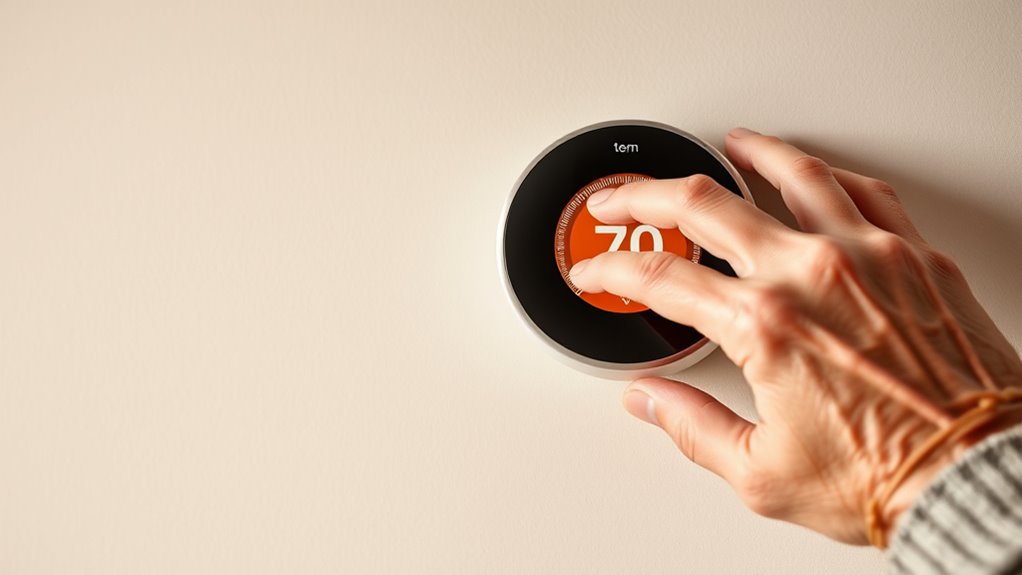
Smart thermostats are quickly becoming essential tools for efficient home heating and cooling. If you’re choosing one for elderly loved ones or someone with accessibility needs, these devices can offer significant benefits in safety, convenience, and energy efficiency. One of the key features to look for is voice control. With voice commands, users don’t need to reach for a display or press buttons, which makes adjusting the temperature simple and safe. Whether they want to increase the heat in a chilly room or lower the AC during hot days, voice control allows for quick, hands-free adjustments. This feature enhances independence and reduces frustration, especially for those with mobility issues or visual impairments.
Another important aspect is energy savings. Smart thermostats designed with accessibility in mind often include learning algorithms that adapt to your loved ones’ routines. Over time, they automatically optimize heating and cooling patterns, reducing unnecessary energy use. This helps lower utility bills while maintaining a comfortable environment. Many models also offer remote access, so you or caregivers can adjust settings from anywhere via smartphone or tablet. This added control is especially useful if your loved one forgets to set the thermostat or if you want to ensure the home stays comfortable when you’re not there.
Smart thermostats save energy and allow remote control for added convenience.
When selecting a smart thermostat, look for user-friendly interfaces and compatibility with voice assistants like Amazon Alexa, Google Assistant, or Apple Siri. These integrations simplify control and make it easier for seniors to operate the device without needing technical skills. Additionally, consider a model with large, clear displays or tactile buttons as a backup for voice commands, ensuring flexibility for different needs. Some smart thermostats include alerts for maintenance or unusual activity, providing added peace of mind. For elderly individuals, this can be a crucial safety feature, alerting caregivers to issues promptly.
Furthermore, understanding support hours and installation options can ensure that help is available when needed and that setup is straightforward for users with mobility challenges. Compatibility with existing heating and cooling systems is essential, so double-check specifications before purchasing. Ultimately, the goal is to find a device that offers intuitive operation, reliable connectivity, and energy-efficient performance. With the right smart thermostat, you can improve your loved one’s quality of life by providing comfort, safety, and energy savings, all with minimal effort.
Frequently Asked Questions
Are Smart Thermostats Compatible With All Home HVAC Systems?
Smart thermostats aren’t compatible with all HVAC systems. Your compatibility depends on your system’s HVAC compatibility, such as whether it uses a traditional or heat pump setup. To guarantee a smooth installation process, check your system’s wiring and compatibility requirements beforehand. You might need a professional to evaluate your HVAC system and assist with installation, especially if you have older or complex setups.
What Safety Features Are Included for Elderly Users?
You’ll find safety features like emergency alerts that instantly notify you or caregivers if something’s wrong, providing peace of mind. Some thermostats include fall detection, alerting loved ones if a fall occurs, like a silent guardian watching over you. These smart features create a safety net, ensuring help is just a tap or voice command away, making your home a secure haven where you feel protected and cared for every moment.
Can Smart Thermostats Be Controlled Remotely Without Internet?
Smart thermostats generally require an internet connection for remote access, allowing you to control them from anywhere via a smartphone app. However, some models offer offline control or manual adjustments directly on the device. Without internet, you can still adjust the thermostat locally, but remote access or remote control features won’t work. To guarantee continuous control, look for thermostats that support offline control and consider local manual operation options.
How Do Smart Thermostats Assist Users With Visual or Mobility Impairments?
You might think smart thermostats are just for tech-savvy users, but they actually help those with visual or mobility impairments too. You can control them using voice commands, making adjustments effortless without needing to see or reach the device. Tactile feedback provides physical cues, confirming your commands. This combination guarantees easier, more accessible temperature management, enhancing comfort and independence for users with impairments.
What Is the Average Setup Time for a Smart Thermostat?
The average setup time for a smart thermostat typically takes about 30 minutes to an hour, depending on your home’s wiring and your familiarity with such devices. During installation, you’ll handle wiring and app setup, but once installed, there’s a brief user learning curve to understand features and controls. With clear instructions, you can usually get your thermostat up and running quickly, making it simple to manage your home’s temperature efficiently.
Conclusion
Choosing the right smart thermostat is like finding a trusted companion that gently guides you through every season. It transforms your home into a cozy sanctuary, adapting effortlessly to your needs. With the right device, comfort becomes second nature—no more worries about chilly mornings or overheated rooms. Embrace this technology as your loyal helper, turning your space into a warm hug whenever you need it. Your perfect comfort partner is just a tap away.
